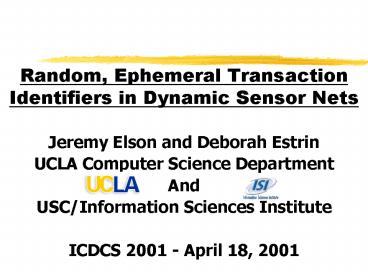Random, Ephemeral Transaction Identifiers in Dynamic Sensor Nets - PowerPoint PPT Presentation
1 / 17
Title:
Random, Ephemeral Transaction Identifiers in Dynamic Sensor Nets
Description:
Low data rates: no space to amortize cost of large (guaranteed unique) IDs ... conflicts (e.g.claim/collide) not amortized over lifetime of the network ... – PowerPoint PPT presentation
Number of Views:44
Avg rating:3.0/5.0
Title: Random, Ephemeral Transaction Identifiers in Dynamic Sensor Nets
1
Random, Ephemeral TransactionIdentifiers in
Dynamic Sensor Nets
- Jeremy Elson and Deborah Estrin
- UCLA Computer Science Department
- And
- USC/Information Sciences Institute
- ICDCS 2001 - April 18, 2001
2
Wireless Sensor Networks
Environmental Monitoring
- New technologies have reduced the cost, size, and
power of micro-sensors and wireless interfaces. - Systems can
- Sense phenomena at close range
- Embedded into environment
- These systems will revolutionize
- Environmental monitoring
- Disaster scenarios
- Fantastic Voyage?
3
New Challenges
- Energy constraints imposed byunattended systems.
- Scaling challenges due to very large numbers of
sensors. - Level of dynamics
- Environmental obstacles, weather, terrain...
- System large number of nodes, failures.
- Were not in the Internet (or Kansas) any more!
- Expensive listening transmitting on idle channel
4
Design Themes
- Localized algorithms
- Do computation if prevents transmission
- In-network processing (e.g. summarization)
- Nodes dont simply route packets!
- Self-configuration
- System should be adaptive, robust...
5
Unique Identifiers Important but Expensive?
- Sensor nets have many uses for unique identifiers
(packet fragmentation, reinforcement, compression
codebooks...) - Its critical to maximize usefulness of every bit
transmitted and received each one brings the net
closer to its death (Pottie) - Low data rates no space to amortize cost of
large (guaranteed unique) IDs - High dynamics cost of assigning local IDs and
resolving conflicts (e.g.claim/collide) not
amortized over lifetime of the network
6
Probabilistic Uniqueness
- Can we use small, random, ephemeral identifiers
instead? - In case of collision do nothing!
- Pick new ID for every transaction this avoids
persistent collisions - Marginal cost of losses from ID collisions is
small compared to losses from dynamics of all
kinds - Sensor nets must be robust to dynamics anyway, so
this does not cost us anything
7
Examples
- Packet Fragmentation
- Senders pick a random ID for each packet
- Receivers demultiplex and reassemble
- Collisions detected through failed checksums
- Interest Reinforcement
- Sensors just need a way to sayWhoever sent
data with ID4 -- more please! - Collisions dont bother detecting them?
8
Advantages of the Scheme
- We can leverage spatial and temporal locality
- Scales beautifully with transaction density
- NOT network size/span, node density, etc.
- Random IDs much smaller than guaranteed unique
ids if total net size large and transaction
density small - Requires no configuration
- In some cases, even promotes good design makes
reacting to dynamics the norm
9
Unique IDs are not evil!
- We arent against assigning IDs...
- (useful for debugging, maintenance, etc.)
- ...only against using them in every packet
- send them as data instead, as needed
10
What About Addresses?
- Nodes in traditional distributed systems all have
addresses, which typically serve as - An address -- i.e., contains topological info
- A uniqifier -- because its convenient
- Sensor nets often dont need case 1
- we are more likely to ask Whats in the NW
quadrant than Whats at sensor 4? - This work came from the question can we do away
with addresses completely?
11
Performance Modeling
- Definition of efficiency
- Bits transmitted Address BitsData Bits
- Static Bits received Data Bits Only
- AFA Bits received Data P(No-Collision)
- P(No-Collision)
(1 - 1/IDspace)
(-open-transactions) note that
IDspace 2address-bits
Useful Bits Received Total Bits Transmitted
(address bits not considered useful)
12
Address-Free Fragmentation
AFF Allows us to optimize bits used for
identifiers Fewer bits fewer wasted bits per
data bit, but high collision rate vs.
More bits less waste due to ID
collisions but
many bits wasted on headers
Data Size16 bits
13
128 bit data (rather than 16)
14
Implementation
- Our SCADDS testbed
- Radiometrix RPC radio (27 byte frames)
- PC104 stacks (just like a PC)
- Uses RETRI for fragmentation, reinforcement
- Test of address-free fragmentation
- Give each node a unique ID
- Report loss due to identifier collisions
- Try a listening heuristic to avoid collisions
15
Testbed Validation of AFF Collision Model 5
Transmitters and 1 Receiver
16
Conclusions
- Random IDs are better than static when
- Data size is small and
- Number of nodes that exist is gtgt number of nodes
mutually communicating and - Efficiency is important
- Pathological case
- All nodes that exist are communicating with all
other nodes at the same time
17
thats all, folks!thank you!































